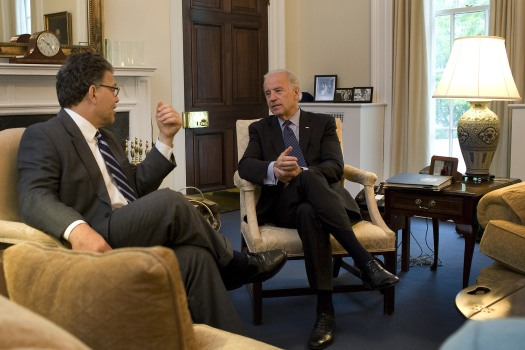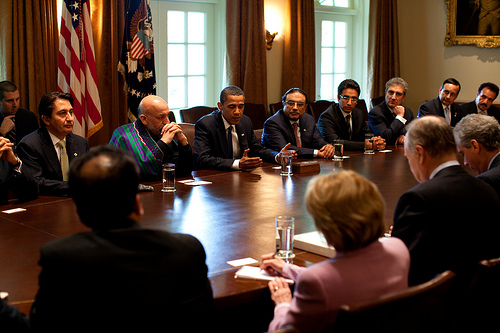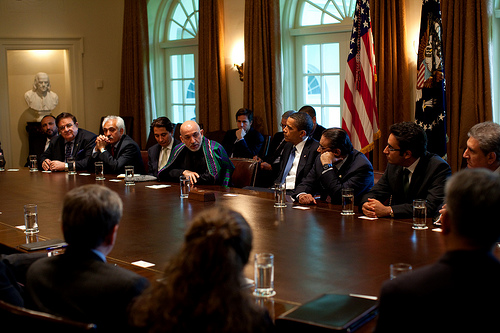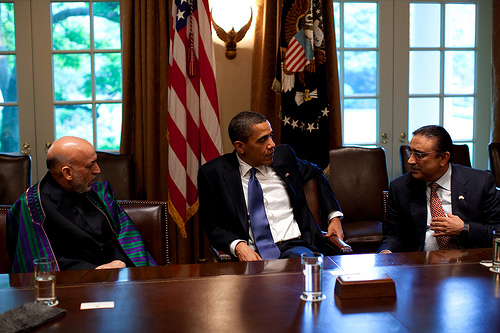THU, MAY 7, 1:07 PM EST
We're doing everything that we can to create jobs and to get our economy moving while building a new foundation for lasting prosperity -- a foundation that invests in quality education, lowers health care costs, and develops new sources of energy powered by new jobs and industries.
But one of the pillars of this foundation is fiscal responsibility. We can no longer afford to spend as if deficits don't matter and waste is not our problem. We can no longer afford to leave the hard choices for the next budget, the next administration -- or the next generation.
That's why I've charged the Office of Management and Budget, led by Peter Orszag and Rob Nabors who are standing behind me today, with going through the budget -- program by program, item by item, line by line -- looking for areas where we can save taxpayer dollars.
He referenced the 100-program volume of
Terminations, Reductions, and Savings released by OMB Director Orszag in his blog post this morning, and went on to give a few examples of how these programs represent the long-standing bad habits in Washington. He mentioned an obsolete navigation system that still gets funding, a literacy program that devotes half its budget to overhead, an a Department of Education outpost in Paris whose work could easily be accomplished here at home.
In addition, we're going to save money by eliminating unnecessary defense programs that do nothing to keep us safe, but rather prevent us from spending money on what does keep us safe. One example is a $465 million program to build an alternate engine for the Joint Strike Fighter. The Defense Department is already pleased with the engine it has. The engine it has works. The Pentagon does not want and does not plan to use the alternative version. That's why the Pentagon stopped requesting this funding two years ago. Yet it's still being funded.
These are just a few examples. But the point to remember is that there are consequences for this kind of spending. It makes the development of new tools for our military, like the Joint Strike Fighter, more expensive -- even prohibitively so -- and crowds out money that we could be using, for example, to improve our troops' quality of life and their safety and security. It makes government less effective. It makes our nation less resilient and less able to address immediate concerns and long-term challenges. And it leaves behind a massive burden for our children and grandchildren.
He closed by reiterating all of the ways the Administration has fought for fiscal discipline already, from supporting "pay as you go" rules, to ending sibsidies for insurance companies, to empowering government employees to find and suggest efficiencies. He pledged that this was just the beginning.
THU, MAY 7, 10:06 AM EST
OMB Director Peter Orszag tells us about the budget being released today, in particular the volume on Terminations, Reductions, and Savings.
We in the Administration have spoken often about the President’s Budget heralding a new era of responsibility—an era in which we not only do what we must to lift our economy out of recession, but in which we also lay a new foundation for long-term growth and prosperity. This means making long overdue investments and reforms in health care, education, and energy. It also means restoring fiscal discipline. We cannot put our nation on a course for long-term growth with uncontrollable deficits and debt, and we no longer can afford to tolerate investments in programs that are outdated, duplicative, ineffective, or wasteful.
That’s why the
Budget we’re releasing today includes a separate volume,
Terminations, Reductions, and Savings, which identifies more than 100 terminations, reductions, or other areas of savings that take nearly $17 billion off the federal government’s bottom line next year alone. About half of the savings for next fiscal year are from defense programs, and about half are from non-defense programs.
The programs in Terminations, Reductions, and Savings are ones that do not accomplish the goals set for them, do not do so efficiently, or do a job already done by another initiative. They include these ten:
· LORAN-C ($35 million). This long-range, radio-navigation system has been made obsolete by GPS.
· Abandoned Mine Lands Payments ($142 million). This program now pays to clean up mines that have already been cleaned up.
· Educational attaché, Paris, France ($632,000). The Department of Education can use e-mail, video conferencing, and modest travel to replace a full-time representative to UNESCO in Paris, France.
· Los Alamos Neutron Science Center refurbishment ($19 million). The linear accelerator housed here was built 30 years ago and no longer plays a critical role in weapons research.
· Even Start ($66 million). The most recent evaluation found no difference between families in the program and those not in it across 38 of 41 outcomes. Strengthening early childhood education is accomplished through significant investments in proven, more effective programs such as Head Start, Early Head Start, and the Early Learning Challenge Fund.
· Christopher Columbus Fellowship Foundation ($1 million). Due to high overhead, the Foundation would spend only 20 percent of its 2010 appropriation on the fellowships it awards.
· Advanced Earned Income Tax Credit ($125 million). This program benefits very few taxpayers, and has an extremely high error rate: GAO found that 80 percent of recipients did not meet at least one of its requirements.
· Javits Gifted and Talented Education Program ($7 million). Grants from this program go to only 15 school districts nationwide, and there are no empirical measures to judge their efficacy.
· Public Broadcasting Grants ($5 million). USDA made these grants to support rural public broadcasting stations in their conversions to digital broadcasting. That transition is now almost complete.
· Rail Line Relocation Grants ($25 million). This program, duplicative of a merit-based program, is loaded with earmarks.
The steps we are detailing in Terminations, Reductions, and Savings are part of the Administration’s larger effort to change how Washington does business and put the nation’s fiscal house in order. Today represents a significant installment in our commitment to review the federal budget line by line.
But our efforts to restore fiscal responsibility have already begun. To date, we have taken the following steps to cut waste, save taxpayer dollars, and make government more effective:
· The Budget includes an historic down payment on health care reform, the key to our long-term fiscal future.
· The Budget will cut the deficit in half by the end of the President’s first term and was constructed without commonly used budget gimmicks that, for instance, hide the true costs of war and natural disasters.
· The Budget will bring non-defense discretionary spending to its lowest level as a share of GDP since we began keeping records in 1962.
· The President has announced a contracting reform effort that will greatly reduce no-bid contracts and help to save $40 billion. In support of this effort, Secretary of Defense Gates, in consultation with our nation’s military leadership, unveiled an unprecedented effort to reform defense contracting.
· The President directed agency heads at the first Cabinet meeting to identify at least $100 million in administrative savings.
· The President personally called on the congressional leadership to pass PAYGO laws so that Congress will be required to adhere to a simple principle: to pay for what it spends.
Now, every one of the programs listed in our Terminations, Reductions, and Savings volume has a supporter, and there will be vocal and powerful interests that will oppose different aspects of this Budget. I am under no illusions that change will be easy, but after an era of profound irresponsibility, I believe that Americans are ready to put problem-solving ahead of point-scoring and to reconstruct an economy built on a solid foundation.
That’s why I know the President will work with Congress to reform and transform Washington, to make these needed cuts so that we use taxpayer dollars to invest in what works and put our nation back on the path toward prosperity for all Americans.
WED, MAY 6, 7:55 PM EST
Last night the First Lady discussed the Social Innovation Fund at the Time 100 Most Influential People Awards; we asked Michele Jolin, Senior Advisor for Social Innovation for the Domestic Policy Council, to tell us about it:
Yesterday, the President announced that he would ask Congress in the FY2010 budget to provide $50 million in seed capital for his Social Innovation Fund, fulfilling a campaign pledge. The Fund will identify the most promising, results-oriented non-profit programs and expand their reach throughout the country.
This is a dramatically different way for the government to do business – and it reflects the President’s new governing approach -- finding and scaling the best social innovations; partnering with those who are leading change in their communities; and creating a policy environment for all these innovations to thrive.
President Obama has said that this is an "all-hands-on-deck" moment and that government cannot solve our nation’s problems alone. He has said that it is critical to partner with citizens, nonprofits, social entrepreneurs, foundations and corporations to make progress on our nation’s great challenges. The President has also talked about finding new solutions to old problems, and this is where the social innovation can play a unique role.
The idea is simple: to find the most effective programs out there and then provide the capital needed to replicate their success in communities around the country that are facing similar challenges. By focusing on high-impact, result-oriented non-profits, we will ensure that government dollars are spent in a way that is effective, accountable and worthy of the public trust.
 (First Lady Michelle Obama attended and gave remarks at the TIME 100 Annual Dinner at the Rose Jazz Center
(First Lady Michelle Obama attended and gave remarks at the TIME 100 Annual Dinner at the Rose Jazz Center
in New York City. She was greeted by (L to R) Jeffrey Bewkes, Chairman of Time Warner Inc., Rick Stengel,
Managing Editor of TIME magazine, and John Huey, Editorial Director of TIME Inc.)
The First Lady also talked more broadly about the need help nurture a new generation of innovators and entrepreneurs who will direct their skills and energy toward solving their community’s – and our nation’s – most serious social problems:
Careers focused on lifting up our communities – whether helping transform troubled schools or training workers for green jobs or helping low-income families access health care – are not always obvious. But, at a time when our nation is facing unprecedented challenges, encouraging careers in public service and social innovation are more important than ever.
The First Lady highlighted the work of a couple of young, new social entrepreneurs.
One example was Rebecca Onie, a creative young woman who founded "Project Health" to help break the link between poverty and poor health. Rebecca organizes college students to staff Help Desks in urban medical centers, universities and community centers. Students then connect low-income families to other critical community and government resources – such as housing vouchers, supplemental nutrition assistance, and educational support.
This is just one example of the kind of social innovation and entrepreneurship that the Obama Administration wants to encourage and replicate in communities across the country.
The Social Innovation Fund will help do that. We recognize that there is no ready and available source of growth capital for programs and ideas that have demonstrated they work and are ready to spread. This gap in the social capital markets is a good niche for government action. The Social Innovation Fund will build a "pipeline" of programs that have demonstrated results and are ready to spread across the country to meet community needs. Now, more than ever, we need to invest in programs that work and find innovative, effective solutions to our nation’s most serious challenges.
WED, MAY 6, 6:34 PM EST
The Vice President met with Al Franken this afternoon, and released this statement afterwards:
"The election process and recount in Minnesota have lived up to the state's reputation for organization, transparency, and bipartisanship. The officials have been meticulous and every ruling has been unanimous.
"While Senator Amy Klobuchar is one of the hardest working members of the United States Senate, Minnesotans deserve their full representation.
"Once the Minnesota Supreme Court has issued its final ruling in this case, the President and I look forward to working with Mr. Franken on building an economy for the 21st century."

[Download Full Size]
(Vice President Joe Biden meets with Al Franken in the Vice President's West Wing office in Washington DC, Wednesday, May 6, 2009. Official White House Photo by David Lienemann.)
WED, MAY 6, 4:36 PM EST
Viewing this video requires Adobe Flash Player 8 or higher.
Download the free player.
download .mp4 (88.5 MB) | read the transcript
Today the President’s schedule was virtually clear except for three pivotal meetings with leaders from two pivotal countries. He was joined by Vice President Biden first for a meeting with President Karzai of Afghanistan, then with President Zardari of Pakistan, and finally for a trilateral meeting with both of them. He was flanked by the two leaders when he
spoke to the press afterwards:
We meet today as three sovereign nations joined by a common goal: to disrupt, dismantle, and defeat al Qaeda and its extremist allies in Pakistan and Afghanistan, and to prevent their ability to operate in either country in the future. And to achieve that goal, we must deny them the space to threaten the Pakistani, Afghan, or American people. And we must also advance security and opportunity, so that Pakistanis and Afghans can pursue the promise of a better life.
He went on to discuss the specific tasks ahead:
There is much to be done. Along the border where insurgents often move freely, we must work together with a renewed sense of partnership to share intelligence, and to coordinate our efforts to isolate, target and take out our common enemy. But, we must also meet the threat of extremism with a positive program of growth and opportunity. That is why my Administration is working with members of Congress to create opportunity zones to spark development. And that is why I’m proud that we’ve helped advance negotiations toward a landmark transit-trade agreement to open the Afghanistan and Pakistan border to more commerce.
Within Afghanistan, we must help grow the economy, while developing alternatives to the drug trade by tapping the resilience and ingenuity of the Afghan people. We must support free and open national elections later this fall, while helping to protect the hard-earned rights of all Afghans. And we must support the capacity of local governments and stand up to corruption that blocks progress. I also made it clear that the United States will work with our Afghan and international partners to make every effort to avoid civilian casualties as we help the Afghan government combat our common enemy.
Within Pakistan, we must provide lasting support to democratic institutions, while helping the government confront the insurgents who are the single greatest threat to the Pakistani state. And we must do more than stand against those who would destroy Pakistan – we must stand with those who want to build. That is why I have asked Congress for sustained funding for schools, roads, and hospitals. I want the Pakistani people to understand that America is not simply against terrorism – we are on the side of their hopes, and their aspirations. Because we know that the future of Pakistan must be determined by the talent, innovation and intelligence of its people.

(President Barack Obama (center) with Afghan President Karzai and Pakistan President Zardari during
a US-Afghan-PakistanTrilateral meeting in Cabinet Room May 6, 2009.
Official White House Photo by Pete Souza)

(President Barack Obama (center) with Afghan President Karzai and Pakistan President Zardari
during a US-Afghan-PakistanTrilateral meeting in Cabinet Room May 6, 2009.
Official White House Photo by Pete Souza )

(President Barack Obama (center) with Afghan President Karzai and Pakistan President Zardari
during a US-Afghan-PakistanTrilateral meeting in Cabinet Room May 6, 2009.
Official White House Photo by Pete Souza)

(President Barack Obama (center) with Afghan President Karzai and Pakistan President Zardari
walk along the Colonnade following a US-Afghan-PakistanTrilateral meeting in Cabinet Room
May 6, 2009. Official White House Photo by Pete Souza)

(President Barack Obama with Afghanistan President Hamid Karzai, Pakistan President Asif Ali Zardari
and Vice President Joe Biden during a statement in the Grand Foyer of the White House May 6, 2009.
Official White House Photo By Lawrence Jackson)

(President Barack Obama, Pakistan's President Asif Ali Zadari and Afghan President Hamid Karzai, give
remarks to the media following their trilateral meeting at the White House Wednesday, May 6, 2009.
Official White House Photo by Chuck Kennedy) TUE, MAY 5, 1:38 PM EST
The President and Mexican Ambassador Arturo Sarukhan got an early start on Cinco de Mayo at the White House last night, as did the First Lady at the Latin American Montessori Bilingual Charter School.
Viewing this video requires Adobe Flash Player 8 or higher.
Download the free player.
download .mp4 (130.0 MB) | also available here | read the transcript

[
Download High Resolution]

[
Download High Resolution]
(First Lady Michelle Obama attends Cinco de Mayo celebration program Monday,
May 4, 2009, at the Latin American Montessori Bilingual Charter School in
Washington, D.C. White House Photos by Samantha Appleton)
TUE, MAY 5, 9:48 AM EST
Yesterday, even before we posted here on the blog about the President's proposals to curb offshore tax havens and end tax incentives for companies shifting jobs overseas, we asked for your reactions on our various social networking outposts. As we expected, there were a lot of interesting comments and questions, largely supporting the President but some raising concerns and objections. We asked Jason Furman, Deputy Director of the National Economic Council, to address some of them:
kylekunkler: Ending deferral (when US already has 2nd highest corporate tax) will only hurt US MNCs and cost jobs! http://tinyurl.com/coofnd
Jason Furman: Kyle, you are correct that the United States has the second highest statutory tax rate in the world, the official rate published in the tax code. But the United States also has more loopholes and special tax preferences than many other countries. As a result, the United States has a much lower effective tax rate. If you look at corporate taxes as a share of GDP they are below those of most major economies. The result is a tax code that is complicated, inefficient and unfair. One of major causes of these problems is the way that we tax – or more often do not tax – the foreign earnings of American companies. The administration’s plan is intended as a major, first step in addressing this problem.
ScottGjerdingen: What sort of jobs would be impacted by Obama's "offshore jobs" corporate cutback on tax benefits?
Jason Furman: Scott, you ask an important question of what jobs would be affected by the President’s proposal. In answering it is important to look at both halves of the proposal. One half is to end special tax preferences for creating jobs overseas. The goal of this is not to stop American companies from competing and succeeding in the global economy. What the President wants is to stop giving them special subsidies for doing so – subsidies they would not get for investing in the United States. The result will be to shift more investment and job creation to the United States. The second half of the policy is to take these savings and use them to cut taxes in businesses that create jobs in the United States by making the tax credit for research & development permanent. The direct beneficiaries of this policy will be companies engaged in research and development, but the innovations that result will have important spillover effects, creating jobs and raising wages across the economy.
Marc Solomon: Bringing jobs back to the US by switching tax incentives from creating jobs overseas to creating jobs in the US is a wonderful idea. My concern is, if the goal is to make our tax laws fairer and simpler, this accomplishes only the first and not the second (and of course that assumes fairer means fairer for US citizens and not for all people of the ... Read Moreworld). Wouldn't just removing the tax incentives for creating jobs overseas accomplish BOTH goals and not just the one? It would definitely simplify the tax laws and be fair for all people, not just U.S. citizens (although, personally, I am prejudiced to being fairer for U.S. citizens).
Jason Furman: Marc, you should understand that today’s announcement is a down-payment on the President’s overall tax agenda. As he said in his remarks today, "the steps I am announcing today will help us deal with some of the most egregious examples of what's wrong with our tax code and will help us strengthen some of these other efforts. It's a down payment on the larger tax reform we need to make our tax system simpler and fairer and more efficient for individuals and corporations." That said, the proposals the President made today would start to simplify the tax code. This includes the President’s proposal to reward companies that create jobs in America – which would make the research and development tax credit permanent, adding more predictability and stability to the tax code because companies would no longer have to worry about whether or not the credit would expire or continue.
MON, MAY 4, 1:06 PM EST
Viewing this video requires Adobe Flash Player 8 or higher.
Download the free player.
download .mp4 (112.9 MB) | also available here | read the transcript
One of the most frequent questions we get, whether through our comment form or through the Open for Questions session we launched for the President’s online town hall, is about the incentives in the tax code for companies to shift jobs overseas. This was one of the top questions in the jobs section, for example:
"What are your plans to encourage corporations to keep middle class jobs, such as customer service call centers and transactional based support services like accounting and computer program jobs, in the U.S?"
PAG, Houston, TX
Today the President answered that question with proposals to curb tax havens and replace tax advantages for creating jobs overseas with incentives to create them here at home.
The President closed
his remarks on a note of basic fairness:
So the steps I am announcing today will help us deal with some of the most egregious examples of what's wrong with our tax code and will help us strengthen some of these other efforts. It's a down payment on the larger tax reform we need to make our tax system simpler and fairer and more efficient for individuals and corporations.
Now, it will take time to undo the damage of distorted provisions that were slipped into our tax code by lobbyists and special interests, but with the steps I'm announcing today we are beginning to crack down on Americans who are bending or breaking the rules, and we're helping to ensure that all Americans are contributing their fair share.
In other words, we're beginning to restore fairness and balance to our tax code. That's what I promised I would do during the campaign, that's what I'm committed to doing as President, and that is what I will work with members of my administration and members of Congress to accomplish in the months and years to come.
1) Replacing Tax Advantages for Creating Jobs Overseas With Incentives to Create Them at Home
· Reforming Deferral Rules to Curb A Tax Advantage for Investing and Reinvesting Overseas
· Closing Foreign Tax Credit Loopholes
· Using Savings To Make Permanent The Tax Credit for Investing in Research and Experimentation at Home
2) Getting Tough on Overseas Tax Havens
· Eliminating Loopholes for "Disappearing" Offshore Subsidiaries
· Cracking Down on the Abuse of Tax Havens by Individuals
· Devoting New Resources for IRS Enforcement to Help Close the International Tax Gap
MON, MAY 4, 10:01 AM EST
This morning Nancy-Ann DeParle, Director of the White House Office of Health Reform, is meeting with rural Americans in the fourth in a series of White House Health Care Stakeholder Discussions.
- Nearly one in five of the uninsured – 8.5 million people – live in rural areas.
- Rural residents pay on average for 40% of their health care costs out of their own pocket, compared with the urban share of one-third.
- In a multi-state survey, one in five insured farmers had medical debt
Late Update: Rebecca Adelman of HHS reports back on the meeting:
Health care in rural America has been a significant topic of conversation at every health reform stakeholder event held at the White House over the past three months, and for good reason. Rural Americans are being hit especially hard by the skyrocketing cost of health care, and many live hundreds of miles away from the physicians and hospitals they need for treatment. Earlier today, representatives from rural communities met with White House office of Health Reform Director Nancy-Ann DeParle to discuss the state of the health care system outside America’s largest cities.
There are nearly 50 million people living in rural America who face unique challenges accessing quality and affordable health care. Rural Americans are more likely to live in poverty, and have fewer providers in their communities. They report more health problems, and are more likely to be without health insurance than citizens living in urban areas. They are also more likely to delay medical treatment because they cannot afford it. According to a new study released today on www.healthreform.gov, nearly one in five of the uninsured – 8.5 million people – live in rural areas.
The meeting participants gathered at the White House included farmers, ranchers, teachers, and fishermen, who spoke of their shared difficulty affording health care. Dr. Wayne Meyers, a pediatrician and organic farmer in rural Maine, summed it up by saying: "For most rural people, cost is the bottom line…health care costs are eating us alive." Many participants expressed frustration that farmers who spend their lives growing healthy food for the nation are struggling to afford medical care they need to live healthy lives. Jon Bailey, Director of the Rural Research and Analysis Program, spoke to the difficulty many small businesses are having in rural areas as they attempt to remain profitable while paying huge sums for health care coverage. Bailey said, "If we don’t solve the health care issues of small businesses, and farmers and ranchers and fishermen in rural areas, we won’t have an entrepreneurial economy, and that means we won’t have much of an economy in rural America."
Mary Wakefield, Administrator of the Health Resources and Services Administration within the U.S. Department of Health and Human Services and Congressman Mike Ross (D-AR) were both on hand to listen. Congressman Ross closed the meeting by thanking Nancy-Ann DeParle and President Obama for their attention to rural health care issues, and for bringing together a diverse group from outside Washington, D.C. to share their experiences and concerns. DeParle made a point to emphasize the President’s commitment to enacting comprehensive health reform that will help rural Americans by lowering costs, guaranteeing choice of doctors and plans, and assuring quality and affordable coverage for all Americans.
SAT, MAY 2, 4:50 AM EST
In his Weekly Address, the President discusses the government’s response to the 2009 H1N1 flu virus, from school closings to activating online social networks. He urges Americans to be calm but cautious.
Viewing this video requires Adobe Flash Player 8 or higher.
Download the free player.
download .mp3 or .mp4 (46.9 Mb) | also available here | read transcript
President Obama: This is also why the Centers for Disease Control has recommended that schools and child care facilities with confirmed cases of the virus close for up to fourteen days. It is why we urge employers to allow infected employees to take as many sick days as necessary. If more schools are forced to close, we’ve also recommended that both parents and businesses think about contingency plans if children do have to stay home. We have asked every American to take the same steps you would take to prevent any other flu: keep your hands washed; cover your mouth when you cough; stay home from work if you’re sick; and keep your children home from school if they’re sick. And the White House has launched pages in Facebook, MySpace and Twitter to support the ongoing efforts by the CDC to update the public as quickly and effectively as possible.